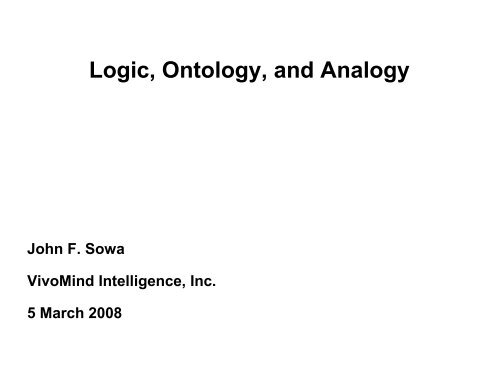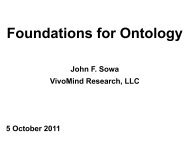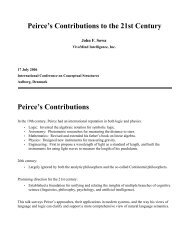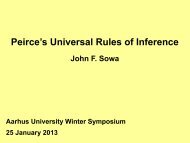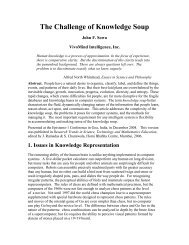Logic, Ontology, and Analogy - John Sowa on Knowledge ...
Logic, Ontology, and Analogy - John Sowa on Knowledge ...
Logic, Ontology, and Analogy - John Sowa on Knowledge ...
You also want an ePaper? Increase the reach of your titles
YUMPU automatically turns print PDFs into web optimized ePapers that Google loves.
<str<strong>on</strong>g>Logic</str<strong>on</strong>g>, <str<strong>on</strong>g>Ontology</str<strong>on</strong>g>, <str<strong>on</strong>g>and</str<strong>on</strong>g> <str<strong>on</strong>g>Analogy</str<strong>on</strong>g><br />
<str<strong>on</strong>g>John</str<strong>on</strong>g> F. <str<strong>on</strong>g>Sowa</str<strong>on</strong>g><br />
VivoMind Intelligence, Inc.<br />
5 March 2008
The Problem of <strong>Knowledge</strong> Representati<strong>on</strong><br />
As stated by the logician Alfred North Whitehead:<br />
Human knowledge is a process of approximati<strong>on</strong>. In the focus of<br />
experience, there is comparative clarity. But the discriminati<strong>on</strong> of this<br />
clarity leads into the penumbral background. There are always questi<strong>on</strong>s<br />
left over. The problem is to discriminate exactly what we know vaguely.<br />
And by the poet Robert Frost:<br />
I’ve often said that every poem solves something for me in life. I go so far<br />
as to say that every poem is a momentary stay against the c<strong>on</strong>fusi<strong>on</strong> of<br />
the world.... We rise out of disorder into order. And the poems I make are<br />
little bits of order.<br />
Poetry <str<strong>on</strong>g>and</str<strong>on</strong>g> logic are complementary approaches to a comm<strong>on</strong> problem:<br />
Create patterns of symbols that capture important aspects of life<br />
in a memorable form.<br />
But those patterns of symbols, in logic or in poetry, are approximati<strong>on</strong>s.
Origin of Formal <str<strong>on</strong>g>Logic</str<strong>on</strong>g> <str<strong>on</strong>g>and</str<strong>on</strong>g> <str<strong>on</strong>g>Ontology</str<strong>on</strong>g><br />
The ancient Greeks had as many lawsuits as modern Americans.<br />
But the plaintiffs <str<strong>on</strong>g>and</str<strong>on</strong>g> defendants had to plead their own cases in court.<br />
The Sophists earned a good living by teaching people how to present<br />
their cases in the best possible light.<br />
Plato criticized the Sophists for ignoring truth <str<strong>on</strong>g>and</str<strong>on</strong>g> trying to make the<br />
weaker case seem to be the str<strong>on</strong>ger.<br />
Aristotle analyzed <str<strong>on</strong>g>and</str<strong>on</strong>g> classified the arguments:<br />
* Deductive methods preserve truth.<br />
* Unsound methods, called fallacies, are plausible, but misleading.<br />
* Syllogisms are deductive methods for reas<strong>on</strong>ing about the<br />
categories of an <strong>on</strong>tology.<br />
* Original meaning of κατεγορια: an accusati<strong>on</strong> in a court of law.
Prospects for a Universal <str<strong>on</strong>g>Ontology</str<strong>on</strong>g><br />
* 4th century BC: Aristotle’s categories <str<strong>on</strong>g>and</str<strong>on</strong>g> syllogisms.<br />
* 17th century: Universal language schemes by Descartes, Mersenne, Pascal, Leibniz,<br />
Newt<strong>on</strong>, Wilkins, <str<strong>on</strong>g>and</str<strong>on</strong>g> others.<br />
* 18th century: More schemes, the Gr<str<strong>on</strong>g>and</str<strong>on</strong>g> Academy of Lagado, Kant's categories.<br />
* 19th century: Roget’s Thesaurus, Oxford English Dicti<strong>on</strong>ary.<br />
* Early 20th century: Many terminologies in many different fields.<br />
* 1960s: Computerized versi<strong>on</strong>s of the terminologies.<br />
* 1970s: ANSI/SPARC C<strong>on</strong>ceptual Schema.<br />
* 1980s: Cyc, WordNet, Japanese Electr<strong>on</strong>ic Dicti<strong>on</strong>ary project.<br />
* 1990s: SRKB, ISO C<strong>on</strong>ceptual Schema, Semantic Web, many workshops.<br />
* 2000s: Many proposals, no c<strong>on</strong>sensus.<br />
Informal terminologies <str<strong>on</strong>g>and</str<strong>on</strong>g> dicti<strong>on</strong>aries have been extremely successful.<br />
Formal systems are still research projects.
Notati<strong>on</strong>s for Representing <strong>Knowledge</strong><br />
Writing a precise statement of knowledge in any language, even<br />
<strong>on</strong>e’s own native language, is not easy.<br />
As Whitehead said, “the problem is to discriminate precisely<br />
what we know vaguely.”<br />
Informal notati<strong>on</strong>s are useful, but many steps are needed to<br />
c<strong>on</strong>vert them to a formal specificati<strong>on</strong>.<br />
C<strong>on</strong>trolled English, as in CLCE, is easy for humans to read, but<br />
humans require c<strong>on</strong>siderable training before they can write it.<br />
C<strong>on</strong>ceptual graphs are an intermediate notati<strong>on</strong> that can be used<br />
in informal methods that can be made precise by systematic<br />
steps.
Example: Tom believes Mary wants to marry a sailor.<br />
C<strong>on</strong>ceptual graph:<br />
C<strong>on</strong>ceptual Graph Interchange Format (CGIF):<br />
[Pers<strong>on</strong> *x1 Tom] [Believe *x2] (Expr x2 x1)<br />
(Thme x2 [Propositi<strong>on</strong><br />
[Pers<strong>on</strong> *x3 Mary] [Want *x4] (Expr x4 x3)<br />
(Thme x4 [Situati<strong>on</strong><br />
[Marry *x5] (Agnt x5 x3) (Thme x5 [Sailor]) ]) ])<br />
Comm<strong>on</strong> <str<strong>on</strong>g>Logic</str<strong>on</strong>g> Interchange Format (CLIF):<br />
(exists ((x1 Pers<strong>on</strong>) (x Believe)) (<str<strong>on</strong>g>and</str<strong>on</strong>g> (= x1 Tom) (Expr x2 x1)<br />
(thme x2 (that (exists ((x3 Pers<strong>on</strong>) (x4 Want) (x8 Situati<strong>on</strong>))<br />
(<str<strong>on</strong>g>and</str<strong>on</strong>g> (= x3 Mary) (Expr x4 x3) (Thme x4 x8)<br />
(Dscr x8 (that (exists ((x5 Marry) (x6 Sailor))<br />
(<str<strong>on</strong>g>and</str<strong>on</strong>g> (Agnt x5 x3) (Thme x5 x6)))))))))))
There is a sailor that Tom believes Mary wants to marry.<br />
C<strong>on</strong>ceptual graph:<br />
CGIF:<br />
[Pers<strong>on</strong> *x1 Tom] [Sailor *x6] [Believe *x2] (Expr x2 x1)<br />
(Thme x2 [Propositi<strong>on</strong>:<br />
[Pers<strong>on</strong> *x3 Mary] [Want *x4] (Expr x4 x3)<br />
(Thme x4 [Situati<strong>on</strong><br />
[Marry *x5] (Agnt x5 x3) (Thme x5 x6) ]) ])<br />
CLIF:<br />
(exists ((x1 Pers<strong>on</strong>) (x6 Sailor) (x2 Believe))<br />
(<str<strong>on</strong>g>and</str<strong>on</strong>g> (= x1 Tom) (Expr x2 x1)<br />
(Thme x2 (that (exists ((x3 Pers<strong>on</strong>) (x4 Want) (x8 Situati<strong>on</strong>))<br />
(<str<strong>on</strong>g>and</str<strong>on</strong>g> (= x3 Mary) (Expr x4 x3) (Thme x4 x8)<br />
(Dscr x8 (that (exists ((x5 Marry)<br />
(<str<strong>on</strong>g>and</str<strong>on</strong>g> (Agnt x5 x3) (Thme x5 x6)))))))))
Methods of Reas<strong>on</strong>ing<br />
Three methods of formal logic:<br />
1. Deducti<strong>on</strong>. Apply a general principle to infer some fact.<br />
Given: Every bird flies. Tweety is a bird.<br />
Infer: Tweety flies.<br />
2. Inducti<strong>on</strong>. Assume a general principle that subsumes many facts.<br />
Given: Tweety, Polly, <str<strong>on</strong>g>and</str<strong>on</strong>g> Hooty are birds.<br />
Tweety, Polly, <str<strong>on</strong>g>and</str<strong>on</strong>g> Hooty fly.<br />
Assume: Every bird flies.<br />
3. Abducti<strong>on</strong>. Guess a new hypothesis that explains some fact.<br />
Given: Every bird flies. Tweety flies.<br />
Guess: Tweety is a bird.<br />
According to Peirce (1902), “Besides these three types of reas<strong>on</strong>ing there is a<br />
fourth, analogy, which combines the characters of the three, yet cannot be<br />
adequately represented as composite.”
Four Views of Analogical Reas<strong>on</strong>ing<br />
1. By logicians:<br />
Deducti<strong>on</strong> is reas<strong>on</strong>ing from “first principles.”<br />
<str<strong>on</strong>g>Analogy</str<strong>on</strong>g> is an unsound, but interesting heuristic.<br />
2. By psychologists:<br />
<str<strong>on</strong>g>Analogy</str<strong>on</strong>g> is a fundamental cognitive mechanism.<br />
Language <str<strong>on</strong>g>and</str<strong>on</strong>g> reas<strong>on</strong>ing depend heavily <strong>on</strong> analogy.<br />
3. Theoretical:<br />
<str<strong>on</strong>g>Analogy</str<strong>on</strong>g> is a very general pattern-matching process.<br />
Deducti<strong>on</strong>, inducti<strong>on</strong>, <str<strong>on</strong>g>and</str<strong>on</strong>g> abducti<strong>on</strong> depend <strong>on</strong> disciplined uses of analogy.<br />
4. Computati<strong>on</strong>al:<br />
A powerful <str<strong>on</strong>g>and</str<strong>on</strong>g> flexible technique for reas<strong>on</strong>ing, learning, <str<strong>on</strong>g>and</str<strong>on</strong>g> language processing.<br />
But practicality depends <strong>on</strong> finding analogies efficiently.
Example of <str<strong>on</strong>g>Analogy</str<strong>on</strong>g>: How is a cat like a car<br />
Data from WordNet <str<strong>on</strong>g>and</str<strong>on</strong>g> other sources are translated to c<strong>on</strong>ceptual graphs.<br />
The VivoMind <str<strong>on</strong>g>Analogy</str<strong>on</strong>g> Engine (VAE) starts at the nodes for Cat <str<strong>on</strong>g>and</str<strong>on</strong>g> Car<br />
<str<strong>on</strong>g>and</str<strong>on</strong>g> tries to find the l<strong>on</strong>gest matching paths through the graphs.<br />
All analogies found are ranked by a semantic-distance measure.<br />
The above analogy received the highest score for that pair of words
Operati<strong>on</strong>s Performed During Pattern Matching<br />
Following paths from each starting node:<br />
[Cat]→(HasPart)→[Head]→(HasPart)→[Eye]→(HasPart)→[Cornea]<br />
[Car]→(HasPart)→[Hood]→(HasPart)→[Headlight]→(HasPart)→[GlassPlate]<br />
Matching c<strong>on</strong>cept nodes with similar types, properties, <str<strong>on</strong>g>and</str<strong>on</strong>g> relati<strong>on</strong>s:<br />
• Head <str<strong>on</strong>g>and</str<strong>on</strong>g> hood are in the fr<strong>on</strong>t.<br />
• Eyes <str<strong>on</strong>g>and</str<strong>on</strong>g> headlights are related to light.<br />
• Cornea <str<strong>on</strong>g>and</str<strong>on</strong>g> glass plate are transparent.<br />
• Paws <str<strong>on</strong>g>and</str<strong>on</strong>g> wheels support the body, <str<strong>on</strong>g>and</str<strong>on</strong>g> there are four of each.<br />
Approximate matching (ignoring the nodes in red):<br />
[Cat]→(HasPart)→[Mouth]→(Flow)→[Esophagus]→(Flow)→[Stomach]→<br />
→(Flow)→[Bowel]→(Flow)→[Anus]<br />
[Car]→(HasPart)→[FuelCap]→(Flow)→[FuelTank]→<br />
→(Flow)→[Combusti<strong>on</strong>Chamber]→(Flow)→[Muffler]→(Flow)→[ExhaustPipe]<br />
Note: The source data did not c<strong>on</strong>tain informati<strong>on</strong> about the pipe from the fuel cap<br />
to the fuel tank. That missing part would have matched the esophagus of the cat.
Three Methods Used by VAE<br />
1. Matching c<strong>on</strong>cept types, in order of increasing semantic distance:<br />
• Identical types.<br />
• Subtype - supertype.<br />
• Siblings of same supertype.<br />
• More distant cousins.<br />
2. Matching subgraphs:<br />
• Match isomorphic subgraphs independent of type labels.<br />
• Merge adjacent nodes to make them isomorphic.<br />
3. Finding metalevel mappings that can relate subgraphs,<br />
— even though they are not isomorphic.<br />
Methods #1 <str<strong>on</strong>g>and</str<strong>on</strong>g> #2 are used for the Cat-Car example.<br />
Method #3 (combined with #1 <str<strong>on</strong>g>and</str<strong>on</strong>g> #2) is used for aligning <strong>on</strong>tologies.
Criticisms of <str<strong>on</strong>g>Logic</str<strong>on</strong>g>al Deducti<strong>on</strong><br />
Deducti<strong>on</strong> in mathematics can be precise, but deducti<strong>on</strong> about any<br />
empirical subject must depend <strong>on</strong> prior inducti<strong>on</strong>, which is almost always<br />
incomplete.<br />
Criticism by the physician, Sextus Empiricus (2nd century AD):<br />
Every human is an animal.<br />
Socrates is human.<br />
Therefore, Socrates is an animal.<br />
If the major premise was derived by checking every human,<br />
then Socrates was c<strong>on</strong>sidered, <str<strong>on</strong>g>and</str<strong>on</strong>g> the argument is circular.<br />
Otherwise, the inducti<strong>on</strong> was incomplete, <str<strong>on</strong>g>and</str<strong>on</strong>g> the c<strong>on</strong>clusi<strong>on</strong> is uncertain.<br />
Criticism by the legal scholar, Ibn Taymiyya (14th century AD):<br />
Every empirical theory is derived by inducti<strong>on</strong> from cases.<br />
Any deducti<strong>on</strong> from such a theory can be obtained by applying<br />
analogical reas<strong>on</strong>ing to exactly the same cases.
Example of Case-Based Reas<strong>on</strong>ing<br />
Reas<strong>on</strong>ing by cases is essential in business, medicine, <str<strong>on</strong>g>and</str<strong>on</strong>g> law.<br />
Example by Ibn Taymiyya:<br />
1. Given case: Grape wine is prohibited.<br />
2. Questi<strong>on</strong>: Is date wine prohibited<br />
3. Cause: Grape wine is prohibited because it is intoxicating.<br />
Date wine is also intoxicating.<br />
4. Judgment: Date wine is also prohibited.<br />
More complex cases have multiple aspects <str<strong>on</strong>g>and</str<strong>on</strong>g> mitigating<br />
circumstances.<br />
But any distincti<strong>on</strong>s that can be formalized in a theory can also be<br />
discovered <str<strong>on</strong>g>and</str<strong>on</strong>g> applied by means of analogy.
Reas<strong>on</strong>ing by Cases <str<strong>on</strong>g>and</str<strong>on</strong>g> by Theory<br />
A diagram of Ibn Taymiyya’s argument:<br />
If the same cases are used, analogy can give the same answer in <strong>on</strong>e step<br />
that requires two steps by inducti<strong>on</strong> followed by deducti<strong>on</strong>.<br />
What Ibn Taymiyya did not recognize: If the same theory can be reused<br />
for many different applicati<strong>on</strong>s, deducti<strong>on</strong> is more efficient.
<str<strong>on</strong>g>Logic</str<strong>on</strong>g> as a Disciplined Use of Analogies<br />
The structure-mapping operati<strong>on</strong>s of analogy are used in every kind of logical<br />
reas<strong>on</strong>ing:<br />
* Deducti<strong>on</strong>. Every step requires a unificati<strong>on</strong>, which is special case of the<br />
structure mappings used in analogies.<br />
* Inducti<strong>on</strong>. Analogies are used to find comm<strong>on</strong> generalizati<strong>on</strong>s of multiple<br />
instances.<br />
* Abducti<strong>on</strong>. The operati<strong>on</strong> of guessing or forming an initial hypothesis,<br />
called abducti<strong>on</strong>, requires analogies to find likely causes or explanati<strong>on</strong>s.<br />
In both human reas<strong>on</strong>ing <str<strong>on</strong>g>and</str<strong>on</strong>g> computer implementati<strong>on</strong>s, the same underlying<br />
operati<strong>on</strong>s can support both logical <str<strong>on</strong>g>and</str<strong>on</strong>g> analogical reas<strong>on</strong>ing.
Applicati<strong>on</strong> to Educati<strong>on</strong>al Software<br />
A textbook publisher needs to evaluate student answers to math questi<strong>on</strong>s.<br />
* Free-form answers in English sentences.<br />
* Much harder to evaluate than multiple choice.<br />
Typical questi<strong>on</strong>:<br />
The following numbers are 1 more than a square: 10, 37, 65, 82.<br />
If you are given an integer N that is less than 200,<br />
how would you determine whether N is 1 more than a square<br />
Explain your method in three or four sentences.<br />
How could a computer system evaluate student answers<br />
Determine whether they are correct, incorrect, or partially correct<br />
And make helpful suggesti<strong>on</strong>s about the incorrect answers
Publisher’s Current Procedure<br />
To evaluate new exam questi<strong>on</strong>s, the publisher normally<br />
gives the exam to a large number of students.<br />
For each questi<strong>on</strong>, they get about 50 different answers:<br />
* Some are completely correct<br />
— but stated in different ways.<br />
* Some are partially correct<br />
— <str<strong>on</strong>g>and</str<strong>on</strong>g> the teacher says what is missing.<br />
* Others are wr<strong>on</strong>g<br />
— in many different ways.<br />
Result: 50 pairs of student answer <str<strong>on</strong>g>and</str<strong>on</strong>g> teacher resp<strong>on</strong>se.<br />
Each pair of (answer,resp<strong>on</strong>se) is a case for case-based reas<strong>on</strong>ing.
Three Teams Addressed this Problem<br />
Team #1 used a large deductive knowledge base.<br />
* <str<strong>on</strong>g>Ontology</str<strong>on</strong>g> for mathematical word problems.<br />
* English parser to analyze student answers.<br />
* Theorem prover to determine if the answers are correct.<br />
Team #2 used Latent Semantic Analysis (LSA).<br />
* Measure the similarity of student answers to correct answers.<br />
VivoMind team used case-based reas<strong>on</strong>ing.<br />
* Intellitex to translate student answers to c<strong>on</strong>ceptual graphs.<br />
* VAE to compare student CGs to correct <str<strong>on</strong>g>and</str<strong>on</strong>g> incorrect CGs.
Results for Team #1<br />
Extending the <strong>on</strong>tology for each problem type was too difficult for<br />
most high-school teachers.<br />
Student answers had too many fragmentary <str<strong>on</strong>g>and</str<strong>on</strong>g> ungrammatical<br />
sentences to be parsed correctly.<br />
The theorem prover could not reach a c<strong>on</strong>clusi<strong>on</strong> for most of the<br />
student answers.<br />
The method was c<strong>on</strong>sidered impractical.
Results for Team #2<br />
LSA methods usually give good results for measuring the<br />
similarity of texts that are l<strong>on</strong>ger than a single paragraph.<br />
They are less reliable <strong>on</strong> texts of just a few sentences.<br />
They cannot discriminate between answers that interchange words<br />
or insert an extra word, such as 'not'.<br />
They were unreliable for distinguishing correct answers from<br />
incorrect answers.
Intellitex Parser<br />
VivoMind has developed a parser named Intellitex:<br />
* Uses a rather simple grammar.<br />
* Depends <strong>on</strong> analogies for interpreting sentences.<br />
* Generates c<strong>on</strong>ceptual graphs as output.<br />
* Robust: always generates some CG as its best guess.<br />
These properties are important for h<str<strong>on</strong>g>and</str<strong>on</strong>g>ling typical student answers,<br />
which frequently have poor grammar <str<strong>on</strong>g>and</str<strong>on</strong>g> incomplete sentences.<br />
Minor errors are not necessarily bad — provided that<br />
Intellitex makes the same errors c<strong>on</strong>sistently in all cases.
Using VAE to Evaluate Student Answers<br />
Use VAE to compare each new answer to the 50 cases:<br />
1. For all 50 cases, translate student answer to c<strong>on</strong>ceptual graphs.<br />
2. Translate each new answer to a new CG.<br />
3. Compare the new CG to the 50 CGs for previous answers.<br />
4. Use the measure of semantic distance to determine the best match.<br />
5. If there is a good match, print out the corresp<strong>on</strong>ding resp<strong>on</strong>se.<br />
6. Otherwise, send the new answer to a teacher to evaluate.<br />
Result:<br />
VAE found a good match for nearly all of the student answers.<br />
For each good match, the previous teacher’s resp<strong>on</strong>se was appropriate.<br />
When VAE failed to find a good match, the new case could be<br />
added to the list of cases in order to improve its coverage.<br />
There is no need for the teachers to write rules, programs, or <strong>on</strong>tologies.
C<strong>on</strong>clusi<strong>on</strong>s<br />
No evidence of formal logic as a prerequisite for learning, underst<str<strong>on</strong>g>and</str<strong>on</strong>g>ing,<br />
or speaking a natural language.<br />
Comm<strong>on</strong> logical operators — <str<strong>on</strong>g>and</str<strong>on</strong>g>, or, not, if-then, some, every — are<br />
present in every NL. But they are used in many different senses, which<br />
include classical first-order logic as an important special case.<br />
Reas<strong>on</strong>ing by analogy is fundamental. Inducti<strong>on</strong>, deducti<strong>on</strong>, <str<strong>on</strong>g>and</str<strong>on</strong>g> abducti<strong>on</strong><br />
are important, highly disciplined special cases.<br />
But analogy is a more general reas<strong>on</strong>ing method, which can be used even<br />
with images, prior to any versi<strong>on</strong> of language.<br />
No evidence of a highly axiomatized <strong>on</strong>tology for any natural language.<br />
But many important comm<strong>on</strong>alities result from comm<strong>on</strong> human nature,<br />
experience, <str<strong>on</strong>g>and</str<strong>on</strong>g> activities.<br />
Formal, logic-based systems with deeply axiomatized <strong>on</strong>tologies have been<br />
fragile <str<strong>on</strong>g>and</str<strong>on</strong>g> limited in their coverage of natural language texts.<br />
<str<strong>on</strong>g>Analogy</str<strong>on</strong>g>-based systems with loosely defined terminologies can be far<br />
more robust <str<strong>on</strong>g>and</str<strong>on</strong>g> efficient for many applicati<strong>on</strong>s.


